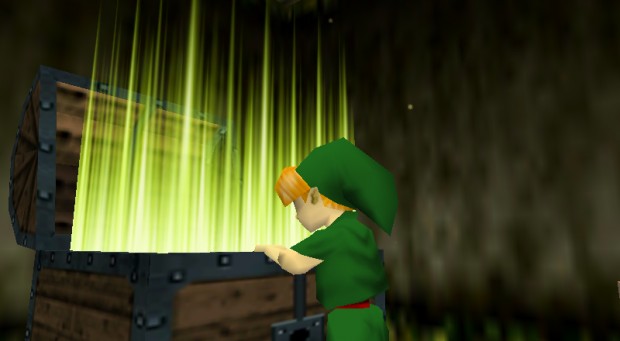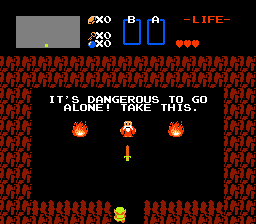
I was trying for a few weeks to write a review of the remake of Legend of Zelda: Ocarina of Time on the 3DS and I couldn’t do it. It was too hard. I was lost to the experience of the thing and knew that I’d simply gush over the new graphics and old storyline and have little to say about the quality of the thing. Then, like a porcine Robert Pirsig, I began to think about the quality of the thing and why Zelda plays such an important part in my life and the lives of an entire generation.
The Legend of Zelda came out at a crucial point in history. Launched in August, 1987, the game appeared on the cusp of the Iran-Contra hearings and its launch coincided with a major LA earthquake. To children of the 1970s who were just coming into their own (I was 12 then), it was a frightening and confusing time. I was too young to understand the world, yet old enough to be afraid of it. I don’t want to conflate world events with the launch of a game, but I think it’s accurate in this case and, at the very least, helps explain some of the world as we (or I) saw it.
Zelda was also important technologically. It was one of the first with a battery-powered save as well as an in-depth story. Compared to the games we had already played by then – Super Mario Brothers and Metroid come to mind – this game was cerebral and deep. Link, our tiny onscreen avatar, survived on wits, not speed, and barring a foolish move you could keep playing for hours, moving from dungeon to dungeon with each thrilling button tap.
Link was us, but better. He was small and squat, looking like a boy with a too-big shield and sword, yet he was quite capable. He could run from enemies, push big rocks (with the right tools), and bomb walls. We were rewarded when he was rewarded because we were in there with him. I can’t recall how many childhood obsessions were fueled by Link’s actions including my desire to be a wizard and my research into esoterica like the Holy Grail. Pop culture at this point was looking backwards and, in a way, Zelda was the definitive example of this. Indiana Jones was digging up the past. Link was in some misty Brigadoon where kids needed swords to defend themselves and invisible enemies sprang up at every turn. Link would save the princess and, in turn, we would save the princess.
Every generation gets the Link it deserves. The N64 crowds got a quasi-3D link and kids these days get a real-3D link and, when Skyward Sword launches, they will get a Link that is so far removed from the original flat, overhead view as to evoke the comparison between the walls at Lascaux vs. the work of Ansel Adams. But I think we’re lucky that we get any Link at all. Too many generations have grown up with heroes too complex for their needs. The hard-eyed superheros and hedonistic Fritzes of previous generations built men and women who lacked a certain amount of compassion. As “bad” as video gaming is for kids, it was the first medium that allowed children to identify with the characters on the screen in a real sense, and, seemingly cognizant of this, Nintendo was careful not to make those role models too violent, too valiant, or too fake.
 The original Zelda, with its dungeons, rupees, and mysterious whistles, is like a strange song whose notes, sometimes cacophonous, came together in a rush of discovery and enchantment.
The original Zelda, with its dungeons, rupees, and mysterious whistles, is like a strange song whose notes, sometimes cacophonous, came together in a rush of discovery and enchantment.
So yes, I loved the Ocarina of Time but I’m supposed to. It’s Umami for the heart, comforting and all-encompassing, a game the envelops the gamer like a good – if flawed – book (what’s with all these flying postmen? And trains? Luckily Ocarina eschews a lot of these newer additions). But this game isn’t for me. It’s for my son and his son and then there will be a next chapter for his son’s son. Forever, into infinity, one would hope, the game will be our gift to the future.
Nick Paumgarten put it best in an article about Zelda’s creator, Shigeru Miyamoto: Zelda is about fear and discovery. I didn’t want to bring Miyamoto into this very much because, as much as I love Zelda, I think the cult of personality that has grown up around him clouds the value of his produce. He did his job and he did it well and his own childhood shaped our own in a myriad of ways. On visiting about a mountain and its warren of small caves that Miyamoto once explored as a child, Paumgarten writes:
I wandered around in the brush for a while longer but found no other open holes. Visible below, in the valley, was a running track, a soccer pitch, and a giant dirt lot, where you could hear the shouts and screams of children at play. I bushwhacked back to the cab, and we drove around to where the sounds had been coming from: a schoolyard. I stood at the edge of it for a spell and watched a bunch of boys, aged nine or so, play a frenzied and unruly game of kickball. On one side of the yard, a group of girls were playing something else. One at a time, they dashed in and out of the brush at the foot of Komugi Mountain. The object, it seemed, was to venture in deeper, or stay in longer, than the girl before.
Deeper, longer, and braver. That’s what I like to think Zelda made us, and I like to think that her mark is indelible.